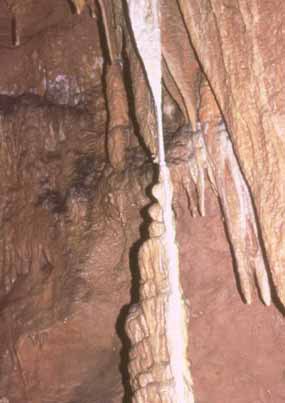
How are Caves are Made? Round Spring Cave is found in a kind of rock called dolomite. It is similar to limestone. Like limestone, dolomite is formed at the bottom of the sea. This part of Missouri was covered by the sea. Later on, forces from inside the earth pushed up the sea bottom to make the Ozarks. These forces, pushing up on the rock layers, cracked the dolomite, much like a baseball hitting a window cracks the glass. These cracks are called joints. This was the very start of Round Spring Cave, and it happened just as the dinosaurs started to roam the Earth. As rainwater fell on the ground, it picked up a small amount of acid from the rotting leaves. This acid, called carbonic acid, is the same thing that gives soda pop its fizz. This acidic water can dissolve holes in dolomite. Below the water table, the rock was filled with this acidic water. Between the layers of rock and inside the joints, the water slowly dissolved away the rock. This made a large water-filled space. As the Current River cut its river valley, it cut down through the rock layers until it opened up the cave. This let the water out and gave us an air-filled cave. How Does Water Move Underground? Water from rainfall still moves into the cave today. A small amount seeps through the rock. This seepage gets filtered as it comes down. It is clear, but not always pure water. Most water that enters the cave comes down through the joints, which connect the cave with the surface. Where there are many joints, sinkholes can form on the surface. Sinkholes act like funnels, collecting rain water from the surface and funneling it into the cave. At some caves, joints leading down from sinkholes have become so big that people can enter the cave through the sinkholes. Sometimes, a cave can pirate water from a surface stream. Just as a pirate took treasure away from someone else, a cave may take water away from a surface stream. If a stream crosses a joint, water may flow down the joint and into the cave. On the surface, water may be flowing down the stream, and then just disappear. This is called a losing stream. Like sinkholes, a losing stream usually means that there is a cave nearby. All of this water that enters the cave has to go somewhere. It is no surprise that many caves have springs flowing out of them. Caves are not cut off from the rest of the world. Many have a constant flow of water moving in and out of the cave all of the time. This water carries the clay, which becomes cave mud This is natural. Unfortunately, people have often used sinkholes for trash dmps. This means that some caves get lots of junk in them. This is bad for the people and animals that depend on the caves for their water. 1. Do you drink spring water or well water that comes from caves? 2. Do you think it is a good idea to fill sinkholes with garbage? 3. What can happen if you do? 4. How many ways can water get into caves? Calcite Deposits or Speleothems Remember that all this water moving into the cave carries carbonic acid. Just like sugar dissolves in water, the mineral calcite is dissolved out of the rock by the acidic water and carried down into the cave. When the water drips down into the cave, it deposits calcite on the ceiling. Each drop deposits a little ring of calcite, building a long hollow tube. These are called soda straws, because they look like the straws through which you sip a soda. This happens very slowly, often taking 100 years for a straw to grow only one inch. Once one is broken, it takes a long time to grow back. A soda straw is the beginning of a stalactite. "Stalactite" has a "c" in it, and a stalactite is a calcite deposit that sticks tightly to the ceiling. A soda straw becomes a stalactite when the inside of the tube becomes blocked. Unable to run down the inside, water runs down the outside, depositing calcite and thickening the soda straw. The stalactite continues to grow as long as the water keeps dripping. Water that drips onto the floor of the cave also leaves calcite behind. This builds up into a stalagmite. Stalagmite" has a "g" in it, and a stalagmite is a calcite deposit that grows up from the ground. If a stalagmite gets tall enough, it might reach a stalactite. When a stalactite and a stalagmite grow together, they form a column from floor to ceiling. Stalactites, stalagmites, and columns are called dripstone because they are deposited by dripping water. Flowing water also deposits calcite, making flowstone. A flowing stream of water can even build dams of flowstone across itself. These are called rimstone dams. Scientists call all of these calcite deposits "speleothems" from Greek words meaning cave rock. Back to More Than Skin Deep Index |
Last updated: April 10, 2015
